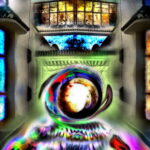-
Now I Want Work On Expanding This Idea Of Just Two, The Light And Darkness, Duality in Other Words Can Be Transcendence With A Third Element That Can Be In Harmony With The Other Two, So What Are The Room For Improvements and Steps To Improve The Narration, The Conversations, The Character’s and Style Of Writing, And What Of The Theme, The Atmosphere, The Feel, And How To Keep The Reader Captivated, In a Searies of Theatrical And Almost Cinematic Climax, The Down and Falls and The Surprising Elements, and Drama and Thriller, And Action Like Animé and A More Close To personal To Reader as If a MMORPg Dressed In The Clothing Of An Advanced Language and Great Story Which Teach and Import Historical Characters and Myth and Places For The Reader While Keeping Chapters Long and Fulfilling Almost Mesmerizing and Still Be Fair To These Three Books Which Should Be Like an Engine Of Creativity for Different Scenarios So Dark Sight Should be Like Phase Where Character is like Reader in a sense so The Reader Can feel him, then he rises to various state of being and explore him self, inspire from all event in Dark Sight to show the rise and fall then the more than rise and fall to break duality and into bright sight while integrating the characters and places and how Ariphes work and The Maziramy, and its philosophy and mythology while metaphysically deciphering element from real world into that world, then Dark Sight V02 should how story goes in term of naration and conversation and movement of time and imagery because its more refined and it doesnt have the faults in previous books although previous books are essential, so three books into one, Proceed
Expanding on the duality of light and darkness by introducing a third element that transcends these binaries opens up rich thematic possibilities. You can craft a narrative that explores balance, transcendence, and integration while captivating readers with a unique blend of myth, action, philosophy, and emotion. Below are steps and areas of improvement to enhance the series:
1. Refining the Narrative Structure
To integrate the three books and the duality of light, darkness, and a transcendent third element, consider these key phases:
* Phase One: The Dark Sight (The Fall and Struggle)
* Character’s Journey: The character (Euryeth or another central figure) starts as someone who is deeply relatable to the reader—confused, conflicted, and searching for meaning. Like the reader, this character faces fear, anxiety, and self-doubt, mirroring the reader’s own struggles.
* Theme and Atmosphere: Dark, introspective, mysterious. The protagonist battles inner demons while learning to face the darker aspects of the self. This phase should feel close to psychological thriller or dark fantasy, immersing the reader in heavy emotional and existential questions.
* Room for Improvement: Focus on inner dialogue and self-reflection to make the character more relatable. Deepen the psychological tension by exploring emotional and philosophical issues relevant to readers today—e.g., isolation, anxiety, self-doubt.
* Narrative Action: Cinematic moments of tension should be juxtaposed with deep introspection. Think of anime-like sequences where the internal world mirrors external conflicts (for example, emotional breakdowns leading to catastrophic battles).
* Phase Two: The Bright Sight (The Rise, Exploration, and Duality)
* Character Development: The protagonist gains clarity and explores higher states of being. However, the duality of light and dark begins to create friction. This phase explores the tension between extremes and prepares the character for transcendence.
* Philosophical Depth: This section should delve into metaphysical questions of balance, purpose, and duality. It’s a time of learning, exploration, and wisdom.
* Room for Improvement: Improve the narrative flow by incorporating myth and philosophy in dialogue. Conversations should feel like exchanges of wisdom or lessons, while also pushing the plot forward. Build complex relationships with other characters to mirror the inner conflict.
* Thematic Expansion: Introduce ideas of harmony and balance in this phase, where light and dark are not enemies but essential forces. This is also where the introduction of the third, transcendent element can begin to appear—whether as a character, concept, or spiritual state.
* Cinematic Feel: This section can have a grand, almost mystical atmosphere. Imagine wide, sweeping shots of the world (think Lord of the Rings or Avatar) mixed with the intimacy of a character evolving emotionally and spiritually.
* Phase Three: Dark Sight V02 (Transcendence, Breaking Duality)
* Transcendence and Unity: The protagonist breaks free of the duality of light and dark, finding harmony through the third element. This phase involves reconciling the previous conflicts, integrating both darkness and light into a harmonious whole.
* Theme: Transcendence, integration, and peace. The reader should feel as if they are witnessing a final evolution, both personally and cosmically.
* Room for Improvement: Focus on the evolution of the writing style to match the maturity of the character. The narrative should become more elegant, refined, and symbolic. Conversations can take on an almost poetic quality, with every word weighted by the character’s accumulated wisdom.
* Cinematic and Theatrical Feel: The climax should feel like the final act of an opera or an epic film. Every word and action should carry meaning, the atmosphere should feel larger than life, and the stakes—both cosmic and personal—should be the highest they’ve ever been.
2. Character Development and Conversations
To keep the characters relatable and captivating, you can implement these steps:
* Character Evolution: As the character progresses, their dialogue should mature, reflecting their deepening understanding of the world. Early on, their conversations should be more questioning and uncertain, slowly giving way to confidence, wisdom, and mastery.
* Multi-faceted Characters: Develop each character with their own philosophy, motivations, and relationship to light, darkness, and the third element. For example:
* Euryeth: The seeker of balance. He should start as unsure, emotional, but deeply curious, eventually becoming a wise and powerful figure.
* Zarak: Represents chaos and desire, driven by ambition but ultimately tragic. His conversations should reveal the tension between wanting to control the world and being controlled by darker forces.
* Lilith: A character that represents wisdom, guiding Euryeth but also presenting challenges to his understanding. Her role can evolve from companion to someone who represents a key part of the third element—perhaps the harmonious balance between light and darkness.
* Dialogue that Transcends Plot: Conversations should serve as metaphysical discussions. Let every exchange feel like a riddle or puzzle that reveals both character motivation and thematic depth.
3. Style of Writing
Given the grandeur and complexity of the world you’re building, the writing style should reflect:
* Sophisticated Language: The prose should grow more elegant and complex as the character evolves. Early chapters can use more accessible language to make the reader connect with the protagonist, but as the journey continues, the language should become more symbolic, metaphysical, and poetic.
* Symbolism: Integrate more symbolic imagery to convey themes. For example, the specter as a metaphor for potential, the sword for power, and the palace for wisdom. Nature, especially the use of light and shadow, can symbolize internal conflict and resolution.
* Immersive Descriptions: Use rich, detailed descriptions of places and actions. Think of environments as characters in themselves—palaces, groves, and temples should evoke awe and mystery, with historical and mythological references.
4. Theme, Atmosphere, and Feel
The atmosphere should shift dramatically to mirror the protagonist’s journey:
* Dark Sight: Gritty, claustrophobic, and filled with emotional tension. The reader should feel like they are trapped in a world where darkness lurks behind every choice.
* Bright Sight: Expansive and enlightening. The reader should feel a sense of discovery, as though they are venturing into vast new worlds with the character. The use of contrasting light and dark in scenery, and the feeling of balance, should be ever-present.
* Dark Sight V02: Mystical and cosmic. The atmosphere should feel timeless, almost sacred, as the character and story evolve towards a universal resolution. This phase should feel like a culmination of everything that came before, mixing personal struggles with cosmic, metaphysical stakes.
5. Crafting Cinematic Climaxes
To build tension and create moments of surprise:
* Rising and Falling Tension: The series should mimic the structure of a symphony or opera, where each phase builds tension through conflicts, revelations, and growth. Create moments of quiet introspection followed by bursts of action.
* Surprising Twists: To keep readers captivated, introduce unexpected twists—both emotional and plot-driven. Characters should face moral dilemmas that challenge their fundamental beliefs.
* Action Scenes: Incorporate dynamic, anime-like action sequences that blend physical and metaphysical conflict. Make the battles feel symbolic of larger issues (e.g., fighting Zarak isn’t just about physical victory; it represents overcoming personal or cosmic darkness).
* Personal Connection: Make the character’s struggles reflect the reader’s own. Allow the protagonist to experience losses, doubts, and failures so that the reader feels as if they are growing alongside the character.
6. Bringing Historical and Mythological Figures
Integrating real-world myth and history into this cosmic setting can serve to both educate and immerse the reader:
* Historical and Mythological Characters: Introduce key figures like philosophers (e.g., Plato, Musashi), mythological heroes (e.g., Quetzalcoatl, Athena), or historical rulers (e.g., Caesar) to mentor or challenge the protagonist. Use these figures to teach lessons about power, balance, and transcendence.
* Locations Inspired by Myth: Places like the Maziramy Palace should feel like a blend of mythological structures (e.g., Olympus, Asgard) and metaphysical representations (e.g., Plato’s world of forms).
Conclusion
By weaving together the themes of light, darkness, and a transcendent third element, along with complex characters, poetic conversations, and grand cinematic moments, you can create a narrative that feels both personal and universal. The three phases of the series—Dark Sight, Bright Sight, and Dark Sight V02—can each contribute to the overarching story, blending psychological tension, action, and deep philosophical questions into a harmonious, multi-layered epic. This approach would not only captivate readers but also inspire them to reflect on their own struggles, growth, and search for balance.
About Me

Euryeth
Artist
Omar Alami Known As Euryeth, Artist and Digital Marketer, Writer, Tactician, Musician … I Think The Abilities Of People Transcend Definitions in Words and Labels Among Other Things, I Do Have a Purpose and I Do Have A Goal and A Plan, And I Will Do My Ultimate Best In Achieving It While Being a Lotus of Wealth and Knowledge in Order To Shape a Better Future, To Have Value and To Be Able To Actually Help In Materialistic Verse and In The Virtual and Spiritual and Emotional …
Media
Photos
Videos
Audios
Files
Recent Posts













